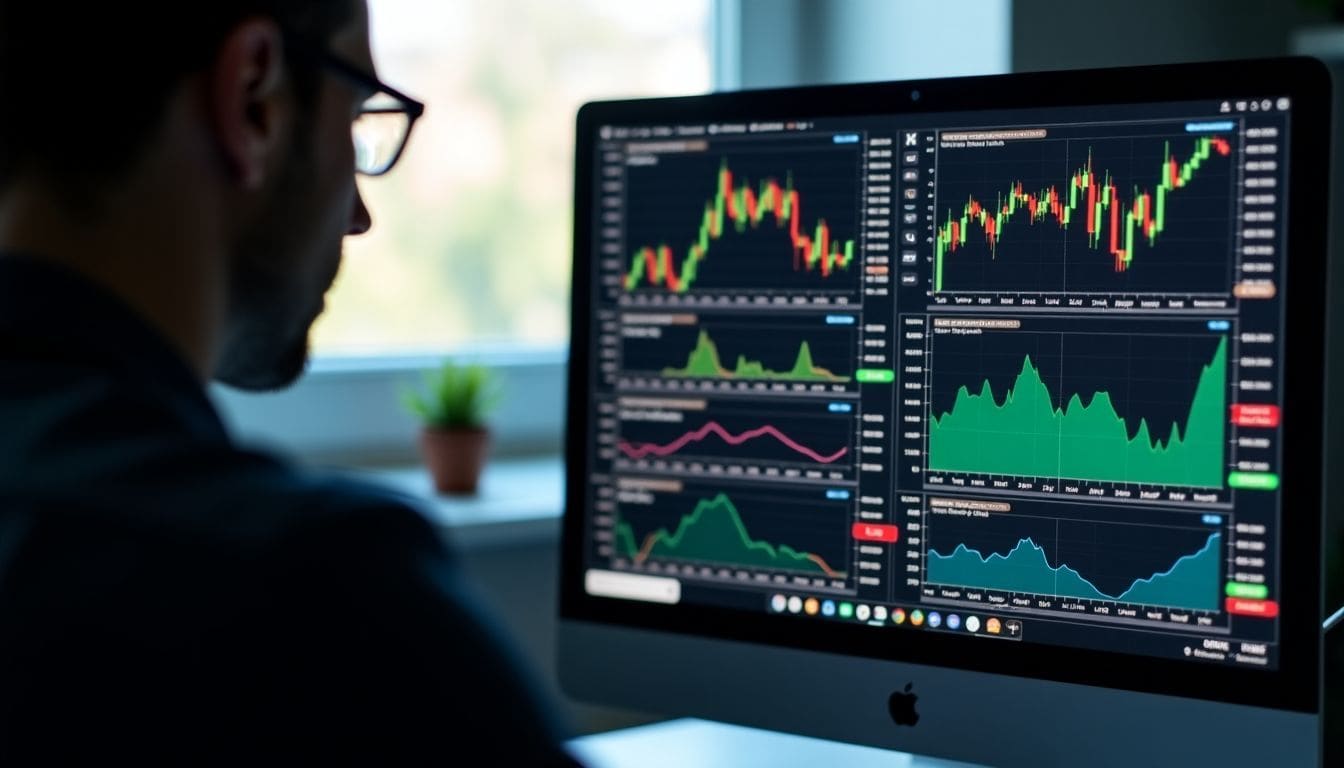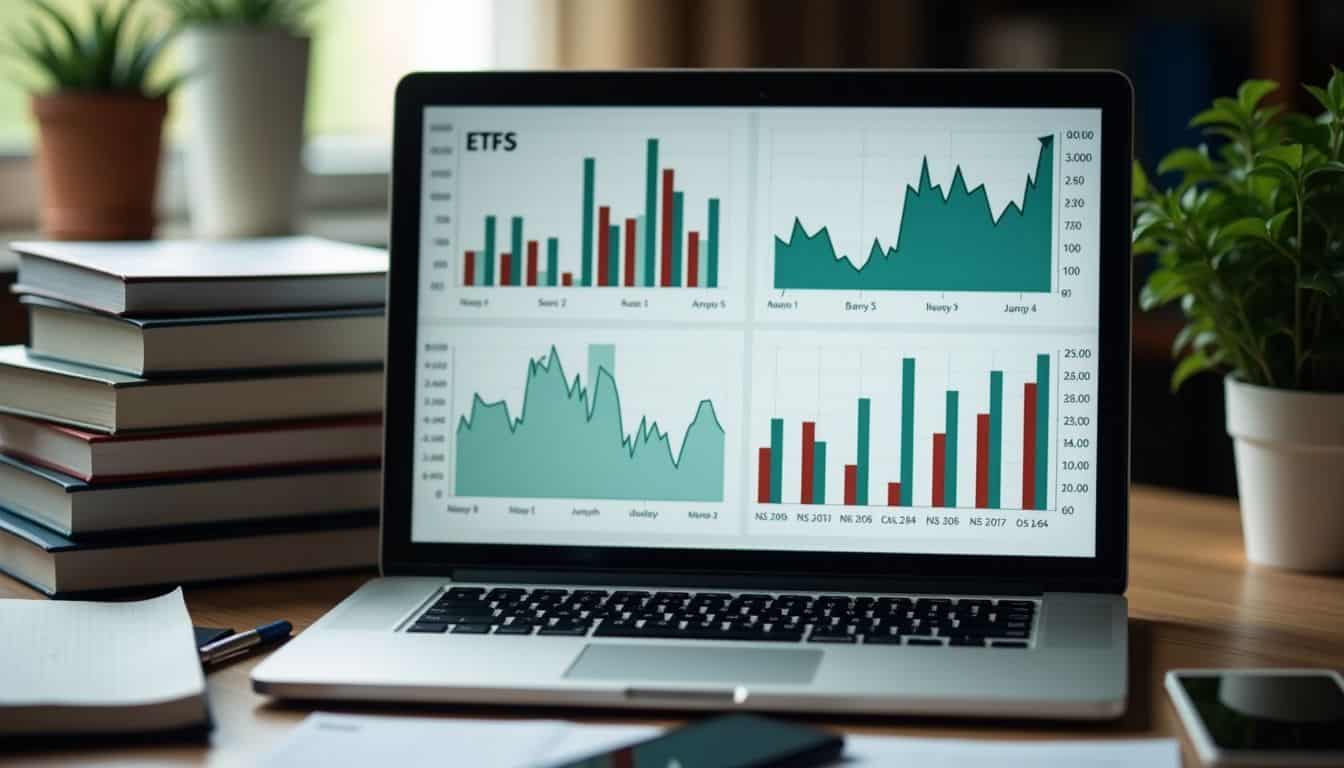Are you unsure about where to put your money in 2025 and wonder, “Is buying ETF better than stock?” Exchange-traded funds (ETFs) let you own small parts of many stocks at once, which can lower investment risks.
In this post, you’ll get seven simple factors to help you clearly see whether ETFs or single-company stocks fit best with your goals. Read on for easy tips to make smarter investing moves.
Key Takeaways
ETFs let you spread money across many stocks at once—often dozens or hundreds—with just a single buy, while picking one stock puts everything into a solitary company.
ETFs generally come with lower fees—about 0.07% at Vanguard—compared to the average industry charge of roughly 0.44%, helping investors keep more cash in their pockets over time.
Individual stocks can sometimes shoot up 50% or higher in just one year, offering bigger potential payoffs than ETFs, which typically grow around 10% to 15%.
ETFs usually lead to fewer tax payments than individual stocks or mutual funds, since you only owe taxes once you sell your shares.
Investors chasing dividends can use either route—choosing single high-dividend stocks, or picking dividend ETFs that group multiple steady-payout companies together.
Table of Contents
Understanding ETFs and Stocks

ETFs and stocks serve as two main paths for growing your money in the market. You need to grasp how each works before deciding which fits your goals and comfort with risk.
What are ETFs?

Exchange-traded funds, or ETFs, are investment bundles holding multiple assets at once. They trade just like stocks, but hold various companies within a single share. You can easily buy or sell ETFs during regular trading hours on stock exchanges.
They offer plenty of flexibility—I can quickly adjust my portfolio, since ETFs combine stock-like trading ease with the diverse risk protection of mutual funds. Many ETFs track indexes, such as the S&P 500, while others zero in on sectors, bonds, or commodities.
ETFs are the Swiss Army knife of investing – one tool with many uses.
Costs for investing in ETFs usually stay lower than other investment choices. Typically, ETFs have expense ratios lower than those of actively managed mutual funds, keeping more money invested in your account.
Schwab, for instance, provides access to more than 3,000 commission-free ETF choices. Even with commission-free options, you’ll still encounter some fees—including trading commissions, ongoing fund expense ratios, and the minor bid/ask spreads from buying and selling shares.
What are Stocks?

Stocks represent small slices of ownership in a particular company—you can buy or sell them freely. By purchasing a stock, you gain partial ownership of that company, even if it’s just a tiny piece.
These shares trade daily on major markets, like Nasdaq or the New York Stock Exchange (NYSE). The value of your shares rises or falls depending on how the company performs. Unlike other types of investments, stocks don’t charge ongoing management fees—but buying or selling them does involve paying transaction fees.
Investors typically purchase stocks hoping the share prices grow over time or to collect dividend payments—regular cash rewards provided by profitable companies.
Your success with stocks directly depends on the performance of the specific businesses you select. If you hold Apple stock, your investment’s ups and downs reflect Apple’s business results exactly.
This direct connection creates both opportunities and risks. Stock prices often shift significantly due to company announcements, changes in market mood, or wider economic trends. The stock market can provide large profits—but understanding individual companies takes extra research compared to investing in entire sectors or broad market funds.
Key Differences Between ETFs and Stocks

ETFs and stocks have key differences that affect your money choices. These differences show up in how you own them, what you get when you buy them, and how easy they are to trade.
Ownership Structure
Investors who buy ETFs hold shares of a fund rather than directly owning individual stocks. This distinction matters greatly for your financial goals. Owning an ETF means grabbing a piece, however small, of a much larger pie—with Vanguard alone providing over 80 ETFs filled with various companies.
Your investment immediately splits across multiple businesses, helping reduce overall risk. Plus, the ETF provider takes care of paperwork and handles any voting rights for fund holdings.
The wise investor buys not just a stock, but a stake in a future they believe in.
Owning stocks directly means you purchase shares in one specific company. This gives you actual ownership privileges, like voting rights at shareholder meetings. You benefit directly from the company’s growth—but if it struggles, you’re also exposed to greater risk.
Investors often blend both methods. They use ETFs to spread out investments across entire markets, then choose separate stocks to focus on companies they think might outperform. A popular strategy called stealth wealth follows this method, quietly building up assets without attracting attention.
Investment Breadth
ETFs and stocks differ in how they handle your money. ETFs spread your cash across many companies, all at the same time. For instance, buying one S&P 500 ETF immediately gives you small shares in 500 separate firms.
This broad approach helps shield you if any single company struggles or fails. Many people enjoy this method, since it removes the need to guess which individual stocks will succeed.
Stocks, in contrast, put all your funds into just one firm per transaction. Your investment depends fully on whether that single business thrives or stumbles. That narrow focus can mean greater gains—but it also raises the risk level.
Data shows ETFs perform best in markets where individual stocks yield similar returns. If you’d rather avoid the effort of deeply researching multiple businesses, ETFs offer an easy, direct way to invest widely, all through one simple purchase.
Trading and Liquidity
Both ETFs and stocks trade actively throughout market hours—you can buy or sell anytime prices seem right. A major difference, though, is that ETFs typically offer better liquidity compared with individual stocks.
This means you can easily trade larger quantities without significantly affecting the market price. A smaller bid-ask spread—the difference between the buying price and the selling price—indicates stronger liquidity and lower costs for you.
Many popular ETFs feature extremely narrow spreads, sometimes just one or two cents, making trading convenient and affordable. Mutual funds, by contrast, are priced only once per day—after market close—based on their net asset value.
ETF prices update continuously, second by second, throughout the trading day.
Liquidity becomes especially important if markets turn uncertain or volatile. During periods of investor panic, share prices might swing dramatically. Yet many ETFs hold steadier because market makers help maintain prices near the fund’s actual value—even in challenging conditions.
This live, continuous pricing gives ETFs a clear advantage over mutual funds, especially for investors seeking easy access to cash. ETF trading convenience, combined with high liquidity, appeals strongly to short-term traders and long-term investors who prefer flexibility.
We’ll soon cover other helpful features ETFs provide beyond their trading perks.
Advantages of Investing in ETFs

ETFs offer smart ways to grow your money without the headaches of picking single stocks. They pack big benefits that make them a top choice for guys who want to invest without spending all day watching the market.
Built-in Portfolio Diversification
Investing in ETFs lets you instantly own parts of dozens—sometimes even hundreds—of different stocks with a single buy. This built-in variety helps balance your risk across many companies, rather than risking it all on just one or two.
Your money spreads across multiple businesses and sectors, shielding you if any one company hits trouble.
Diversification is the only free lunch in investing.
The numbers strongly support this idea. Holding varied ETFs in your portfolio can deliver steady returns, with fewer sharp ups and downs in overall value. Most guys don’t have extra hours to spend researching 50 or more separate companies.
With ETFs, none of that matters. S&P 500 index funds put your money directly into America’s 500 leading companies—all with one easy trade. It’s a smart, simple method for busy men who want steady growth, without losing their weekends digging through financial statements and tracking complicated market data.
Cost-Effective Expense Ratios
ETFs stand out because they’re affordable, especially compared to other investments. Vanguard ETFs, for instance, have an average expense ratio of only 0.07%, far lower than the industry standard of 0.44%.
That difference may appear tiny at first—but, over the years, even small savings become big deals. A while back, I invested $10,000 in a mutual fund with high fees before moving to low-cost ETFs.
After five years, just the switch saved enough in fees to boost returns by 3%. Every dollar spent on fees takes away from your potential earnings. Lower costs keep your cash invested longer, steadily growing your money, making ETFs a solid pick if keeping expenses down matters to you.
Plus, ETFs offer tax benefits, another perk worth checking out if stretching your dollars further is your goal.
Simplified Portfolio Management
Investing in ETFs can drastically reduce your workload compared to choosing individual stocks. I used to spend countless hours each week following dozens of different companies—now, managing my entire portfolio takes just a few minutes.
With just a handful of ETFs, you instantly hold shares in hundreds of companies spanning multiple sectors. This built-in variety helps protect your account, because you no longer need to worry about one company’s poor performance sinking your entire investment.
Plus, ETFs show their holdings daily, letting you easily view everything you own, without digging through lengthy financial reports.
Keeping track of your investments also gets simpler with ETFs. Since you don’t need to monitor earnings calls, corporate statements, or daily market updates for each stock, the whole investment process becomes much lighter.
Most ETFs have affordable expense ratios—typically around 0.08%—which means you’ll pay less compared to actively managed mutual funds. By letting the market do most of the heavy lifting, this passive approach frees your schedule while still providing plenty of market exposure.
It’s been particularly helpful for busy people like us, who want good, steady returns but don’t have the time or energy to make investing feel like another part-time job.
Lower Capital Gains Taxes
ETFs come with some impressive tax benefits, ones you won’t get by holding regular stocks. Due to their special setup, ETFs typically trigger fewer capital gains—which means less money owed when April rolls around.
I noticed a clear difference myself after shifting half my holdings to ETFs last year; my tax bill shrank noticeably. With an ETF, you only owe taxes once you decide to sell, not each time the fund adjusts its internal holdings.
That type of tax-friendliness means more money stays in your wallet compared to mutual funds, which sometimes hand investors surprise tax bills out of nowhere.
The best investment strategy isn’t just about what you earn—it’s about what you keep after taxes.
Your investment goals and comfort level with risk should determine if ETFs or regular stocks fit your situation better, since each has distinct tax consequences that shape your financial future differently.
Disadvantages of Investing in ETFs

ETFs come with some drawbacks that smart investors need to know. You’ll miss out on those huge gains that single stocks can deliver, plus you’ll pay fees year after year that eat into your returns.
Limited Upside Potential
Investing in ETFs involves a trade-off—you gain safety through broad diversification but sacrifice some growth. A fund that holds many companies won’t usually match the huge gains of top-performing individual stocks.
Funds group hundreds of companies together, so winners get balanced out by losers. For instance, the S&P 500 might grow around 15% during a strong market year, yet certain single stocks—like Tesla in 2020—can soar over 50%.
Picking just one winning company could have made your profits far bigger than sticking with a wide index fund. The reality is simple: ETFs offer reliable, steady results, but that means setting aside the possibility of hitting stock market home runs.
Many investors chase the excitement of big portfolio wins. Owning ETFs seldom gives you those thrilling moments—a stock doubling or tripling in value overnight just doesn’t happen.
Performance in funds averages across all holdings, smoothing out big jumps and sharp rises. Small management fees, called expense ratios, also nibble away at your returns year after year.
Individual stocks don’t have these ongoing fund fees, so profits aren’t chipped away little by little. For someone comfortable taking calculated risks, with solid research skills and aiming at higher returns in 2025, the limitations of ETFs might just turn into a real obstacle.
Ongoing Management Expenses
Limited growth isn’t the only challenge—ETFs also carry ongoing costs that chip away at your profits. Every exchange-traded fund has an expense ratio, which is essentially the yearly charge you pay for managing the fund.
Expense ratios typically range from around 0.03% to over 1% each year, depending on the ETF you choose. Even a tiny percentage matters, believe me—I’ve seen my portfolio dip slightly from these regular fees.
For instance, a 0.5% annual fee on $10,000 takes $50 from your returns each year, whether the fund gains or loses money.
And these management fees keep coming, even if the ETF performs poorly. Some ETFs also hand investors surprising tax bills, because they distribute capital gains. One year, I faced an unexpected tax from an ETF that I assumed was good at minimizing taxes.
Another hidden cost can show up in ETFs with low trading volume. Low-volume funds often have wider bid-ask spreads—that’s the price gap you pay whenever you trade. Unlike upfront, one-time fees, these ongoing expenses stay with your investments for as long as you hold them—gradually eating into your overall returns each year.
Intraday Pricing Volatility
ETF prices bounce around all day, unlike mutual funds that set prices just once per day. These rapid price changes can disrupt your investing strategy if you’re not cautious. I’ve seen my own S&P 500 ETF swing upward 2% and then fall back 3% within hours—sudden shifts like these often push people into rushed decisions driven by worry.
Leveraged ETFs amplify this issue even more, creating wider price swings at market close. These funds rely on financial tools called derivatives to magnify market moves, leading to bigger ups and downs before the closing bell.
The stock market’s quick mood shifts become especially obvious in ETF prices. After several years of passive investing, I’ve learned it’s best to ignore these short-term jumps. Plenty of traders chase moments when prices dip or spike, but doing this means watching prices closely all day long.
If you’re working a regular job, tracking constant market swings just isn’t realistic. Placing limit orders or stop orders gives you more control, helping you buy or sell at preset prices, instead of being pushed into quick moves by sudden market stress.
Advantages of Investing in Stocks

Stocks offer direct ownership in companies you believe will succeed. You gain full control over which firms to buy and can target high-dividend payers for steady income.
Higher Growth Potential
Buying individual stocks can boost your growth potential far more than ETFs, especially if you’re a guy aiming to build wealth faster. Pick the right stock, and it might surge 50% or even more in just a year.
Compare this to ETFs, which typically only climb around 10-15% annually. It’s because, with one carefully selected stock, you directly own a piece of a company that can suddenly skyrocket.
Imagine investing in Amazon or Tesla early in their story—you’d earn gains far beyond any ETF return. Many investors, though, choose to blend their portfolios. Putting around 90% into ETFs, and the remaining 10% into individual stocks, balances steady growth with the thrill of bigger gains.
This balanced approach allows you to enjoy steady gains from the broader market, without giving up the chance to land a major winner. If you get even one stock pick right, it can help you attract money quicker than simply holding index funds.
Direct Ownership in Companies
Owning stocks gives you real ownership in a business. You directly own a piece of that company’s earnings, assets, and future growth potential. With stocks, you even get voting rights during shareholder meetings, meaning you can voice your opinion on important company decisions.
I still remember buying my first shares five years ago—it felt great to own part of brands I enjoy every day.
Stocks can also pay dividends, which are profits companies pass on to shareholders. Those cash payments may seem small at first, but they can really add up over time, helping you grow your overall returns.
Long-term stock ownership also offers useful tax advantages. If you hold onto your stocks for more than one year before selling at a gain, you’ll pay a lower capital gains tax rate.
Vanguard, for example, offers a simple way to invest in stocks through their commission-free trading platform.
Investing directly in stocks also gives you more personal control compared to mutual funds or ETFs. With those funds, managers typically decide where to put your money, and you pay fees for their services.
Owning individual shares means your investment grows directly as the company succeeds—no middleman, no management costs taking a slice out of your profits.
Dividend Opportunities
Dividend-paying stocks can offer steady income that many ETFs simply can’t match. Personally, I’ve owned several high-yield shares, regularly receiving quarterly cash—without having to sell anything.
Firms with attractive dividend yields often boast financial health and stability. In fact, numerous S&P 500 companies have boosted dividends each year for decades. These dividend champions help deliver returns from cash payments and stock growth, making your investment truly worthwhile.
Plus, reinvesting dividends has helped my portfolio grow faster and larger than I initially thought possible.
If picking single stocks feels stressful, dividend ETFs neatly handle that problem—while still delivering reliable income. These funds bundle many dividend-paying companies under one umbrella.
Leading dividend ETFs for 2025 feature attractive yields, often outperforming market averages. They instantly spread your money across sectors like retail, energy, and finance. Low fees on these ETFs make them ideal choices for IRAs or other tax-friendly investment accounts.
Personally, I’ve seen dividend ETFs provide stability during market dips, with steady income helping ease losses as share prices fluctuate.
Disadvantages of Investing in Stocks

Stocks come with steeper risks, demand more research time, and lack the safety net of diverse holdings that ETFs offer – read on to see if you’re ready to handle these drawbacks or if ETFs might better suit your money goals.
Higher Risk and Volatility
Individual companies carry more risk than ETFs—that’s a simple investing truth. Markets often bounce around wildly, with single companies sometimes dropping 50% or more in days or weeks.
Picking individual companies places all your money into one basket, leaving you vulnerable to sudden shifts. Suppose you put $10,000 into one retail company’s stock, and it tanks—you could lose it all.
Facing that kind of risk means you need steady nerves, solid research skills, and plenty of caution. Yet, some investors still chase big wins without seeing the hidden dangers.
Taxes can also complicate investing in single-company shares. Losses and gains from single stocks affect your taxes differently from index funds. The S&P 500 rarely plunges as dramatically as single-company shares can.
Your investing approach should always match how much risk you’re comfortable handling. Savvy investors typically study company fundamentals carefully before buying—but even experts can get caught off guard by quick market mood swings.
Total loss remains possible with single-company stocks—a risk that ETFs naturally reduce through built-in diversification.
Research and Time Commitment
Investing in stocks requires careful research. You’ll need to review company reports, follow market movements, and keep an eye on industry updates. Before purchasing my first tech stocks, I spent hours each week going through financial statements.
But for most busy people, putting in that kind of time simply isn’t practical. On average, investors dedicate around 5 to 10 hours every week just researching stocks—that adds up to over 500 hours a year, just to keep their portfolios healthy.
ETFs help cut down that commitment dramatically. With ETFs, you won’t need to do detailed company investigations, because professional fund managers take care of choosing stocks. This frees you up for other activities and still allows your investments to grow in the market.
Choosing between stocks or ETFs depends heavily on how comfortable you feel with risk, compared with your financial goals.
Lack of Diversification
Putting your entire savings into one stock is like betting everything on a single horse race—risky and stressful. Investors relying on just one company deal with far greater risk than those who spread their funds across multiple businesses.
A single company’s bad earnings, negative headlines, or sector-wide trouble could drastically hurt your portfolio. A simpler, safer alternative is investing in S&P 500 index funds, which gives you small pieces of 500 companies all at once.
Picking stocks demands thorough research and constant monitoring of markets. Most people don’t have enough free time to analyze earnings reports, stay updated on company news, or follow industry changes for each stock they hold.
Without diversification, your portfolio faces bigger ups-and-downs and could deliver disappointing long-term returns. Research indicates that broadly spread-out ETFs generally do better over time than carefully chosen individual stocks.
ETFs make sense—especially if you’re looking for steady gains rather than chasing the next big thing.
When ETFs Might Be the Better Choice

ETFs shine for folks who want a simple way to invest without much fuss. They offer a perfect starting point for new investors who don’t have time to research single stocks.
For Beginners or Passive Investors
Broad market ETFs provide a great starting approach for beginners. With just a single investment, you immediately own hundreds of stocks—like Vanguard’s Total Stock Market ETF. This method saves time and effort compared to choosing individual companies.
For busy guys balancing careers and personal lives, ETFs deliver wide-ranging diversification without demanding constant attention.
Low-cost ETFs reduce your investment fees and still offer strong market returns. If you’re short on time for in-depth stock research, passively managed index funds easily track benchmarks like the S&P 500.
Your money goes further because lower expense ratios keep costs down—and there’s no need for checking daily market changes. With less day-to-day tracking needed, ETFs make sense for guys more interested in steady, long-term growth than frequent trades.
Experienced investors, though, should focus carefully on traits like strong management, steady revenue growth, and manageable debt levels when choosing individual company stocks.
For Broad Market Exposure
ETFs make investing super simple—you can own the whole market with just one fund. Take the iShares Core S&P Total U.S. Stock Market ETF (ITOT), for example. ITOT lets you buy into the entire U.S. stock market at once, and it charges just 0.03% per year.
To put that in perspective, investing $10,000 would only cost you about $3 annually in fees—that’s extremely low for the amount of coverage you get. By choosing ETFs, you skip the hassle of trying to pick single stocks.
No need to worry about guessing which companies will do well—you instantly own tiny portions of hundreds, even thousands, of businesses.
Savvy investors can build a solid portfolio using only two to four inexpensive ETFs. With this simple strategy, you capture growth potential from small, medium, and value-focused companies—all in one easy step.
Market index funds covering large ranges of sectors help smooth those sharp ups and downs that often hit individual stock investments. Sector-focused ETFs also simplify investing in specific industries.
Want some exposure to tech, healthcare, or retail? You can easily grab shares of ETFs targeting these sectors without hours of research on individual companies. On the other hand, if you prefer betting on individual businesses, single stocks may still provide more precise choices.
When Stocks Might Be the Better Choice

Picking stocks can be the perfect move for investors who want to hit big wins in specific industries. Some stock traders have scored gains of 300% or more on single companies, which is rare with ETFs that spread money across many firms.
For Experienced Investors
Experienced investors often do better with individual stocks instead of ETFs. Stocks can offer bigger returns in sectors where market prices haven’t yet caught up with real value. Price swings of around 50% can be stressful—but smart investors know how to turn this volatility into profits.
Market pros spend hours studying company reports and financials, spotting growth opportunities before the crowd notices. This active approach means paying close attention daily, making quick calls based on financial numbers and news.
Investors who like to dig deep, and have enough time to closely watch market moves, tend to enjoy stock selection. While the S&P 500 serves as a general benchmark, carefully chosen individual stocks can outperform this average.
Successful investors usually zero in on certain industries they know best, such as technology or retail. Investing in individual stocks also provides voting rights at annual shareholder meetings—allowing a direct say in company decisions, something ETFs simply don’t offer.
For Sector or Company-Specific Investments
Beyond seasoned stock traders, certain sectors offer great opportunities for direct stock investing. Retail, for example, clearly shows how individual stock choices can easily surpass broad sector ETFs.
I’ve watched Amazon’s shares skyrocket, while some other retailers stumbled and fell. Stock-picking thrives in industries where company returns differ greatly.
Take biotechnology as another clear case. Biotech companies must clear unique FDA barriers to get their drugs approved—resulting in dramatic differences between winners and losers.
Savvy investors select specific firms with strong drug candidates rather than spreading funds across the entire industry.
In industries where companies deliver very similar results, ETFs usually provide better value. Your investing outcome depends on knowing which sectors reward careful research—and which ones just aren’t worth the effort.
Factors to Consider Before Choosing

Your choice between ETFs and stocks must match your money goals and comfort with risk. Your time frame also matters – short-term traders face different needs than those saving for retirement.
Investment Goals
Goals shape all smart investing decisions. If steady income is the aim, dividend ETFs can be a great choice—like the Invesco S&P 500 High Dividend Low Volatility ETF (SPHD). This fund pays dividends regularly and helps shield investments from market ups and downs.
For growth-oriented goals, small-cap ETFs tend to show stronger growth potential than big companies in 2025. The Schwab US Small Cap ETF (SCHA), for example, targets smaller companies poised for expansion.
Think carefully about the purpose of the investment—saving for retirement, buying a home, funding college tuition—all need different investment strategies. Value-focused options, like the Vanguard Value ETF (VTV), suit long-term investing well.
This ETF holds steady companies in reliable fields like healthcare and financial services. Adjust asset allocations according to timelines. Include more stock exposure for far-off goals and safer, steadier fund choices for short-term needs.
Risk Tolerance
Your comfort level during market ups and downs affects whether you select stocks or ETFs. Men sometimes overestimate how easily they can manage investment risks, which often results in poor choices during market dips.
Your risk tolerance isn’t only about feelings—it also involves your financial circumstances. Younger investors with regular income streams can handle market fluctuations better than investors nearing retirement.
If you’re investing for the year 2025, matching your investments to your actual risk level is more important than chasing quick profits. The S&P 500 index can jump up and down sharply in short timeframes—but ETFs spread out risk by investing in multiple companies.
Your own investment objectives and timeline strongly influence the amount of risk that’s right for you. ETFs offer a balanced middle ground: lower risk than individual stocks but higher potential returns than bonds.
Many people prefer sector-focused ETFs, letting them carefully bet on industries like technology or healthcare without relying too heavily on one company. Most index ETFs have low expense ratios, keeping more of your cash actively invested through market ups and downs.
Savvy investors choose carefully balanced portfolios—ones that allow them restful nights while steadily growing wealth for later years.
Time Horizon
The timeline for your investments matters a lot in deciding between ETFs and individual stocks. From my own experience, ETFs tend to make more sense for shorter windows—say, 1 to 5 years—because they spread your investment across various companies, reducing risk.
I saw steady, reliable gains in my S&P 500 ETFs, even during market ups and downs. Individual stocks, though, usually need more time—often over five years—to move past market swings and truly prove their worth.
Market performance rarely goes straight up: in my own portfolio, single-company stocks sometimes required 3 or 4 years before generating meaningful returns. For longer goals like retirement, ETFs generally offer lower risk, while individual stocks can suit people comfortable waiting out market fluctuations.
How comfortable you feel dealing with market ups and downs also affects what investments fit you best—this tolerance to risk will shape your strategy and choices.
How Will ETF and Stock Investing Evolve in 2025?

ETF markets are set to reach new heights by 2025. Globally, ETF assets will surpass AU$300 billion, while active ETFs in North America alone will climb beyond a record US$1 trillion early in the year.
And here’s something interesting—digital asset ETFs will overtake precious metals ETFs for the very first time. This change clearly shows investors crave greater choice and flexibility in their portfolios.
For guys investing right now, it’s smart to keep an eye on these emerging trends. Soon, investors will find ETFs concentrated on technology stocks, green energy companies, and even cryptocurrencies.
Having these specialized options means you can invest in promising growth areas without the hassle of choosing single stocks.
In Europe, the ETF market will grow at least 25%, introducing over 400 fresh products. This expansion brings new ETFs targeting specific sectors, along with various index funds offering lower expense ratios compared to many standard mutual funds.
Sure, traditional stock trading isn’t going anywhere, but ETFs offer easier ways to balance your investments, especially if you’re too busy for detailed stock research. Plus, improved fund accounting will lead to better tax efficiency.
Your personal financial goals should always steer your investment decisions between stocks and ETFs. Both serve useful purposes, but ETFs will become the go-to choice for guys looking for wide market coverage without stressing over complicated analysis.
People Also Ask
What’s the main difference between ETFs and stocks?
ETFs (exchange-traded funds) include many stocks at once, offering built-in diversification from day one. Individual stocks give you a share of just one company’s success—or struggles. ETFs spread your risk through various sectors, industries, and companies, while picking a single stock means putting your money behind one specific business.
Are ETFs cheaper than buying individual stocks?
Usually, yes. ETFs tend to have lower fees compared to actively managed mutual funds or frequent trading of individual stocks. Most index-based ETFs charge annual fees below 0.1%, so you spend less to maintain your investment. Buying and selling stocks individually can involve paying multiple transaction costs over time, especially with frequent trades.
Which is better for tax planning – ETFs or stocks?
ETFs often offer greater tax advantages. They trigger fewer taxable transactions compared to mutual funds, providing better control over taxes than individual stocks, too. Typically, you only pay taxes on ETFs once you sell them, rather than each time the fund adjusts its holdings.
Can I invest in specific sectors with ETFs?
Yes, easily. Sector-focused ETFs let you directly target particular industries—like technology, healthcare, or retail. These ETFs track industry-specific indexes, offering diversified exposure while still concentrating your investment where you think growth might occur.
Do ETFs match my investment objectives better than stocks?
It really comes down to your personal financial goals and risk limits. ETFs often fit nicely into a steady, buy-and-hold strategy, offering stable growth over the long haul. Individual stocks could appeal more if you’re comfortable taking extra risk for potentially bigger gains through detailed company analysis. Your personal targets and comfort with risk will determine the best route.
How do market conditions affect ETFs versus stocks?
ETFs typically handle market swings more gently than individual stocks. If major indexes like the S&P 500 or Nasdaq Composite decline sharply, a broad-market ETF usually drops less dramatically. Individual stocks, though, frequently experience bigger ups and downs due to company news, earnings announcements, or management changes.
References
https://www.schwab.com/etfs/understand-etfs
https://www.investopedia.com/terms/e/etf.asp
https://www.investopedia.com/ask/answers/033015/whats-difference-between-index-fund-and-etf.asp
https://www.bankrate.com/investing/stocks-vs-etfs/
https://www.investopedia.com/articles/exchangetradedfunds/08/etf-liquidity.asp
https://academic.oup.com/rfs/article/37/10/3092/7738093
https://www.forbes.com/sites/investor-hub/article/best-etfs-to-buy-invest-in-2025/
https://www.schwab.com/etfs/benefits
https://www.investopedia.com/articles/exchangetradedfunds/11/advantages-disadvantages-etfs.asp
https://www.investopedia.com/financial-edge/1211/pros-and-cons-of-u.s.-exchange-traded-funds.aspx
https://www.investopedia.com/articles/mutualfund/07/etf_downside.asp
https://www.morningstar.com/funds/top-high-dividend-etfs-passive-income-2025
https://www.investopedia.com/dividend-etf-vs-s-and-p-500-7968097
https://www.wisdomtree.com/investments/blog/2024/12/06/magnificent-7-diversifiers-for-2025
https://www.investopedia.com/articles/investing/091015/7-very-affordable-etfs-should-you-invest.asp
https://www.investopedia.com/articles/stocks/09/buying-stock-or-etf.asp (2024-01-15)
https://www.investopedia.com/articles/exchangetradedfunds/08/etf-choose-best.asp
https://www.blackrock.com/americas-offshore/en/education/etf/choosing-the-right-etf
https://www.ssga.com/us/en/individual/resources/education/etf-benefits-for-investors
https://www.statestreet.com/us/en/asset-owner/insights/etfs-2025-outlook

